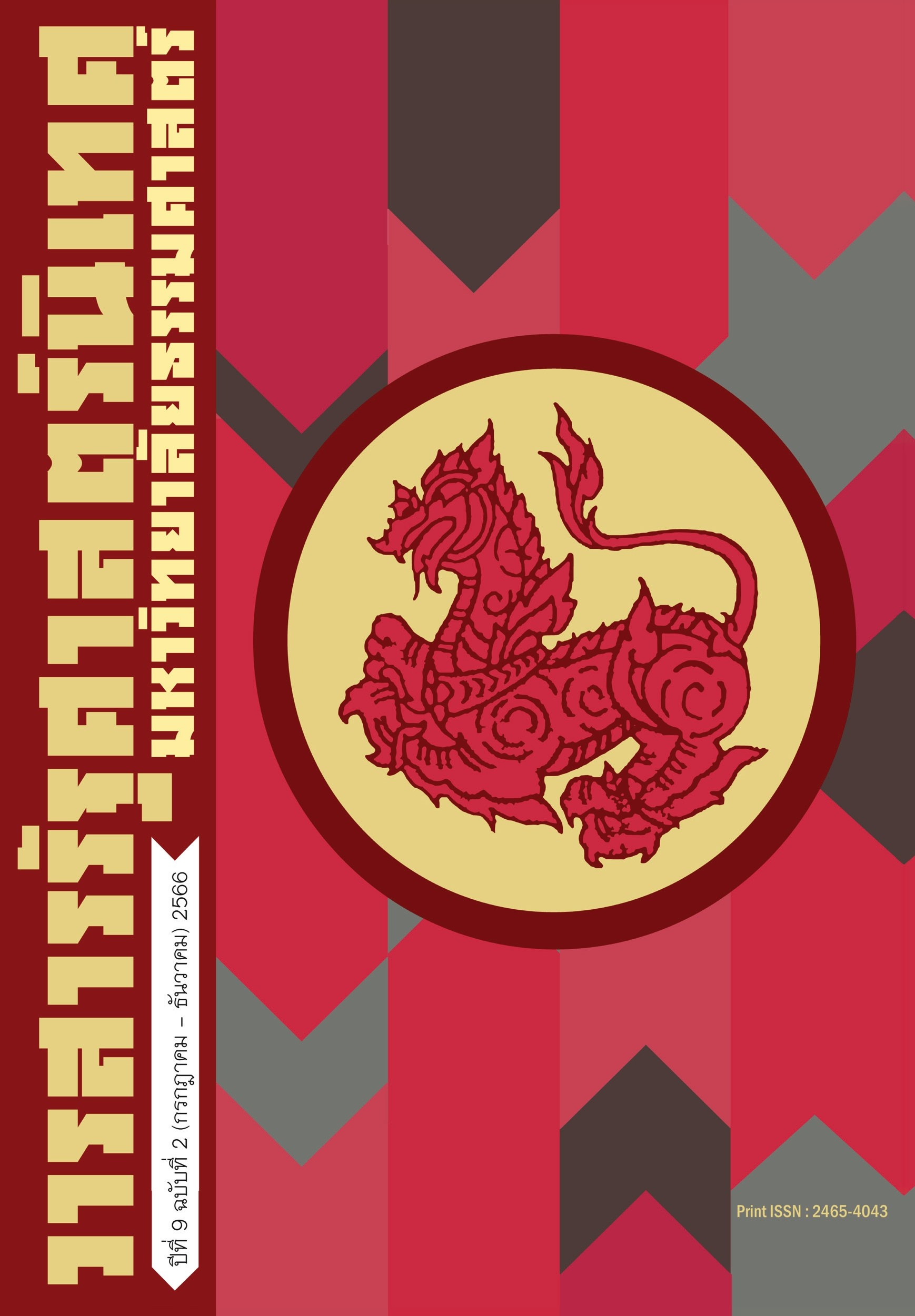ความสำคัญของการอภิบาลด้านเทคโนโลยีสารสนเทศในยุคดิจิทัล
Main Article Content
บทคัดย่อ
การอภิบาลด้านเทคโนโลยีสารสนเทศเป็นแนวทางในการสร้างความสอดคล้องระหว่างกลยุทธ์ด้านเทคโนโลยีสารสนเทศกับกลยุทธ์องค์การ เพื่อช่วยให้องค์การสามารถจัดการความเสี่ยงด้านเทคโนโลยีสารสนเทศได้อย่างมีประสิทธิภาพ และสร้างความมั่นใจให้กับผู้มีส่วนได้เสียต่อการดำเนินงานขององค์การ ดังนั้นการอภิบาลด้านเทคโนโลยีสารสนเทศจึงกลายเป็นสิ่งสำคัญต่อความสำเร็จขององค์การในยุคดิจิทัล ทั้งนี้ในการนำหลักการอภิบาลด้านเทคโนโลยีสารสนเทศไปปฏิบัติให้มีประสิทธิภาพ จะต้องพิจารณาถึงความสอดคล้องของกลยุทธ์ด้านเทคโนโลยีสารสนเทศ การใช้เทคโนโลยีสารสนเทศให้เกิดประโยชน์สูงสุด การบริหารความเสี่ยง การบริหารผลการดำเนินงาน และการบริหารทรัพยากรเป็นสำคัญ โดยบทความนี้ เริ่มต้นจากการทบทวนถึงพัฒนาการของการบริหารงานภาครัฐในยุคดิจิทัล จากนั้นจึงทำความเข้าใจเกี่ยวกับการอภิบาลด้านเทคโนโลยีสารสนเทศทั้งในประเด็นของพื้นหลัง ความหมาย องค์ประกอบ ตลอดจนกรอบวิธีปฏิบัติ กรอบแนวทางปฏิบัติ และมาตรฐานที่มีความเกี่ยวข้องกับการอภิบาลด้านเทคโนโลยีสารสนเทศ
Article Details

อนุญาตภายใต้เงื่อนไข Creative Commons Attribution-NonCommercial-NoDerivatives 4.0 International License.
เอกสารอ้างอิง
Todd Dewett and Gareth R. Jones, “The role of information technology in the organization: a review, model, and assessment,” Journal of Management, Vol. 27, No. 3 (2001), 313-346. https://doi.org/10.1177/014920630102700306 (accessed 31 August 2020).; Nabil Freij and Dennis Zink, Digital Optimization and Transformation for Small Businesses, (SCORE,2022), 48-51.; AIESEC International, https://blog.aiesec.org/it-the-backbone-of-the-world/ (accessed 5 June 2023).
วสันต์ เหลืองประภัสร์, “การจัดการภาครัฐแนวใหม่กับการบริหารปกครองในระบอบประชาธิปไตย: สองกระแสความคิดในการบริหารงานภาครัฐ “ลูกค้า” หรือ “พลเมือง”?,” รัฐศาสตร์สาร, ปีที่ 26 ฉบับที่ 2 (2548), 35-86.
Patrick Dunleavy Helen Margetts, Simon Bastow, and Jane Tinkler, Digital Era Governance: IT Corporations, the State, and E-Government, (United Kingdom: Oxford University Press, 2012), 7.; Owen E. Hughes, Public Management and Administration: An Introduction, 3rd ed., (New York: Palgrave Macmillan, 2003).
วิรัช วิรัชนิภาวรรณ, การบริหารจัดการยุคดิจิทัล, (กรุงเทพฯ: โฟร์เพซ, 2561), 76-93.
Patrick Dunleavy, Helen Margetts, Simon Bastow, and Jane Tinkler, “New Public Management Is Dead-Long Live Digital-Era Governance,” Journal of Public Administration Research and Theory, Vol. 16, No. 3 (2006), 467-494. อ้างถึงใน ธนาพร เต็งรัตนประเสริฐ และ ติญทรรศน์ ประทีปพรณรงค์, “ระบบดิจิทัลภาครัฐเพื่อการอำนวยความสะดวกในการประกอบธุรกิจ: การประเมินผลเชิงคุณภาพในกรณีประเทศไทย,” วารสารสังคมศาสตร์ คณะรัฐศาสตร์ จุฬาลงกรณ์มหาวิทยาลัย, ปีที่ 52, ฉบับที่ 1 (มกราคม-มิถุนายน 2565), 148-169.
OECD, “Recommendation of the council on digital government strategies,” OECD (online), https://www.oecd.org/gov/digital-government/recommendation-on-digital-government-strategies.htm (accessed 2 May 2021).
Daniel J. Veit and Jan Huntgeburth, Foundations of Digital Government: Leading and Managing in the Digital Era, (Berlin: Springer, 2014), 1-17.
เรวัต แสงสุริยงค์, “บนเส้นทางการพัฒนารัฐบาลอิเล็กทรอนิกส์ในสังคมไทย: ยุคก่อนการปฏิรูประบบราชการ,” วารสารวิชาการมนุษยศาสตร์และสังคมศาสตร์ มหาวิทยาลัยบูรพา, ปีที่ 24, ฉบับที่ 46 (กันยายน-ธันวาคม 2559), 35-57, https://so06.tci-thaijo.org/index.php/huso journal/article/view/76682/61613 (สืบค้นเมื่อ 20 เมษายน 2564).
เรวัต แสงสุริยงค์, “บนเส้นทางการพัฒนารัฐบาลอิเล็กทรอนิกส์ในสังคมไทย: ยุคดิจิทัล,” วารสารวิชาการมนุษยศาสตร์และสังคมศาสตร์ มหาวิทยาลัยบูรพา, ปีที่ 27, ฉบับที่ 55 (กันยายน-ธันวาคม 2562), 294-317.
Denise Ko and Dieter Fink, “Information technology governance: an evaluation of the theory-practice gap,” Emerald Group Publishing Limited, Vol.10, No.5 (2010), 662-674, https://ro.ecu.edu.au/ecuworks/6299/ (accessed 22 September 2021).
เป็นกฎหมายกลางของสหรัฐที่วางกรอบข้อกำหนดแก่คณะกรรมการบริษัทมหาชน องค์กรด้านบริหารจัดการ และองค์กรด้านสอบบัญชีสาธารณะทั้งหมดในสหรัฐ
Brown, Carol V., and Sharon L. Magill, “Alignment of the IS Functions with the Enterprise: Toward a Model of Antecedents,” MIS Quarterly, Vol. 18, No. 4 (1994), 371–403, https://doi.org/10.2307/249521 (accessed 19 December 2022).
Sambamurthy, V., and Robert W. Zmud, “Arrangements for Information Technology Governance: A Theory of Multiple Contingencies,” MIS Quarterly, Vol. 23, No. 2 (1999), 261–290, https://doi.org/10.2307/249754. (accessed 19 December 2022).
Peterson, Ryan R., Marilyn M. Parker and Pieter M. A. Ribbers, “Information Technology Governance Processes Under Environmental Dynamism: Investigating Competing Theories of Decision Making and Knowledge Sharing,” International Conference on Interaction Sciences, (2002), https://www.semanticscholar.org/paper/Information-Technology-Governance-Processes-Under-Peterson-Parker/cf33ef8152aacdc9e6ff92b2e2460da616ae89cb (accessed 28 June 2023).
W. Van Grembergen, "Introduction to the mini-track “IT governance and its mechanisms”," Proceedings of the 35th Annual Hawaii International Conference on System Sciences, (2002), 3097-3097, https://ieeexplore.ieee.org/document/994349 (accessed 19 December 2022).
IT Governance Institute, Board Briefing on IT Governance, 2nd Edition, (2003), https://www.s cribd. com /doc/98700375/Board-Briefing-on-IT-Governance# (accessed 31 August 2020).
Scholl, H.J., Kubicek, H.,and Cimander, R., “Interoperability, Enterprise Architectures, and IT Governance in Government,” Lecture Notes in Computer Science, Vol. 6846, (2011), 345-354, https://doi.org/10.1007/978-3-642-22878-0_29 (accessed 19 December 2022).
Tonelli, A.O., de Souza Bermejo, P.H., dos Santos, P.A., Zuppo, and L., Zambalde. A.L., “IT governance in the public sector: a conceptual model,” Information Systems Frontiers, Vol. 19, No.3 (2017), 593-610, https://doi.org/10.1007/s10796-015-9614-x (accessed 11 November 2020).
Pereira, Ruben and Mira da Silva, Miguel, “IT Governance Implementation: The Determinant Factors,” Communications of the IBIMA, Vol. 2012, (2012), https://doi.org/10.5171/2012.970363. (accessed 2 June 2022).
S. De Haes and W. Van Grembergen, “IT Governance Structures, Processes and Relational Mechanisms: Achieving IT/Business Alignment in a Major Belgian Financial Group,” Proceeding of the 38th Hawaii International Conference on System Sciences, (January 2005), 237b-237b, https://doi.org/10.1109/HICSS.2005.362 (accessed 2 May 2021).
Leena Ali Mohamed Janahi, The Importance of Accountability in IT Governance Practice in the Public Sector: A Case Study of the Kingdom of Bahrain. (PhD Thesis, University of Salford, 2016), http://usir.salford.ac.uk/id/eprint/38534/1/ Leena%20Janahi_ Final%20version.pdf (accessed June 6, 2020), 51.
Hardy, Gary., “Using IT governance and COBIT to deliver value with IT and respond to legal, regulatory and compliance challenges,” Information Security Technical Report, Vol.11, No.1 (2006), 55-61, https://doi.org/10.1016/j.istr.2005.12.004, (accessed 2 June 2022).
ARTUR, R., “IT Risk Management in the Context of IT Governance: Theory vs. Practice,” The 6th International Symposium on Risk Management and Cyber-Informatics: RMCI, (July 2009), 296-302.
Peter Weill and Jeanne W. Ross, IT Governance: How top performers manage IT decision rights for superior results, (Boston: HBS press, 2004).
Leena Ali Mohamed Janahi, The Importance of Accountability in IT Governance Practice in the Public Sector: A Case Study of the
GHEORGHE, M., “Audit Methodology for IT Governance,” Informatica Economica, Vol.14, No.1 (2010), 32-42, https://econpapers.repec.org/article/aesinfoec/v3a143ay3a20103ai3a13ap3a32-42.htm, (accessed 2 June 2022).
Van Grembergen, W., “Measuring and Improving IT Governance through the Balanced Scorecard,” Information Systems Control Journal, Vol. 2, No. 1 (2007), 35-42., อ้างถึงใน นพพร แพทย์รัตน์, “การวัดผลเชิงดุลยภาพกับการประเมินขีดความสามารถของบรรษัทภิบาลด้านเทคโนโลยีสารสนเทศ,” วารสารวิจัย มสด, ปีที่ 14, ฉบับที่ 1 (มกราคม-เมษายน 2561), 208-210.
เมธา สุวรรณสาร, “การประเมินตนเองเพื่อควบคุมความเสี่ยง-CSA/Controls Self-Assessment ตอนที่ 8 COSO,” ITGTHAILAND (เว็บไซต์), https://itgthailand.wordpress.com (สืบค้นเมื่อ 1 มีนาคม 2565).
ISACA, “COBIT2019 Framework Introduction and Methodology,” https://www.isaca.org/resources
/cobit (accessed 25 December 2021).
ธนพล นามนวล และ ปรัชญนันท์ นิลสุข, “เรื่องการกำกับดูแลที่ดีด้านเทคโนโลยีสารสนเทศ ในสถาบันอุดม
ศึกษาตามกรอบปฏิบัติ COBIT,” วารสารมนุษยศาสตร์และสังคมศาสตร์ มหาวิทยาลัยธนบุรี, ปีที่13, ฉบับที่ 3 (กันยายน-ธันวาคม 2561),169-180.
Process Symphony, “ITIL 4,” https://wiki.process-symphony.com.au/framework/itil-4/ (accessed 25 December 2021).
Muhamet Gërvalla, Naim Preniqi, Peter Kopacek, “IT Infrastructure Library (ITIL) framework app roach to IT Governance,” IFAC-PapersOnLine, Vol. 51, No. 30 (2018),181-185, https://doi.org/10. 1016/j.ifacol.2018.11.283 (accessed 31 May 2023).
CSSIA, “ISO 27001 Standard,” https://www.cssia.org/wp-content/uploads/2020/01/ISO_27001_
Standard.pdf (accessed 3 January 2022).
Mataracioglu, Tolga and Ozkan, Sevgi, “Governing Information Security In Conjunction With Cobit And Iso 27001,” International Journal of Network Security & Its Applications, Vol.3, (2011), https://doi.org/10.48550/arXiv.1108.2150 (accessed 31 May 2023).


